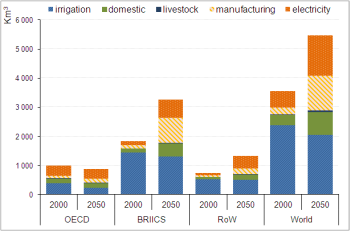Environmental indicators, modelling and outlooks
Water Chapter of the OECD Environmental Outlook to 2050: The Consequences of Inaction
|
Without new policies, by 2050, freshwater availability will be further strained, with 2.3 billion more people than today (in total over 40% of the global population) projected to be living in river basins experiencing severe water stress, especially in North and South Africa, and South and Central Asia. Global water demand is projected to increase by some 55%, due to growing demand from manufacturing (+400%), thermal electricity generation (+140%) and domestic use (+130%). In the face of these competing demands, the Baseline sees little scope for increasing irrigation water. Environmental flows will be contested, putting ecosystems at risks. Groundwater depletion may become the greatest threat to agriculture and urban water supplies in several regions. Nutrient pollution from urban wastewater and agriculture is projected to worsen in most regions, intensifying eutrophication and damaging aquatic biodiversity. The number of people with access to an improved water source (although not necessarily safe water for human consumption) is expected to increase, essentially in the BRIICS. However, globally more than 240 million people are expected to be without such access by 2050. Sub-Saharan Africa is unlikely to meet the Millennium Development Goal (MDG) of halving by 2015 the 1990 level of the population without access to an improved water source. The MDG for sanitation will not be met by 2015; by 2050 1.4 billion people are projected to be still without access to basic sanitation. |
Global water demand: Baseline scenario, Note: BRIICS: Brazil, Russia, India, Indonesia, China, South Africa. RoW: Rest of the world. Source: The Environmental Outlook Baseline; output from IMAGE model suite. Download Data in excel |
|
Video - Water: Balancing demand |
OECD Secretary-General Speeches and News releases |
|
Source: (OECD, 2012) OECD Environmental Outlook to 2050, output from the IMAGE model (PBL).
|
Related Events
More information: |
Related Documents
- The Water Challenge: OECD's Response
